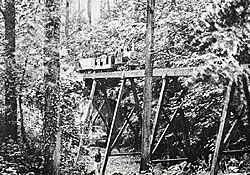Duffield Bank Railway
 |
|
| Locale | England |
|---|---|
| Dates of operation | 1874–1916 |
| Track gauge | 15 in (381 mm) |
| Length | 1 mile (1.6 km) |
| Headquarters | Duffield |
The Duffield Bank Railway was built by Sir Arthur Percival Heywood in the grounds of his house on the hillside overlooking Duffield, Derbyshire in 1874. Although the Ordnance Survey map circa 1880 does not show the railway itself, it does show two tunnels and two signal posts.
Sir Arthur wished to explore the possibilities of such railways for mining, quarrying, agriculture etc. He believed that they would be relatively easy to build, and to move. He saw possibilities for military railways behind the lines carrying ammunition and supplies. Some other small railways had been built to 2 ft gauge, but he wished to use the minimum that he felt was practical. Having previously built a small railway of 9 in (229 mm) gauge, he settled on 15 in (381 mm).
Duffield Bank is a fairly steep hillside to the east of the village. Over a period of about seven years, the track reached about one mile (1.6 km) long with tunnels and some very sharp curves and steep gradients. He included some stations, and to demonstrate the versatility of such a line, to the freight trucks, he added passenger coaches, as well as a sleeping car with toilet and a diner with its own cooking compartment.
His first engine was an 0-4-0T "Effie" not as a final design, but simply to provide motive power for his first experiments. Like his other locos, however, it used a boiler with a cylindrical "launch"-type firebox manufactured by Abbott and Company of Newark-on-Trent. Without the fire box projecting below the barrel, the over-hang of the frame was equalized at each end, without the use of trailing wheels, since he wished to concentrate the weight on the driving wheels. It also, he felt, had a low first cost with relatively easy maintenance. Such a system had already been used by Ramsbottom for some shunting engines for the London and North Western Railway, and worked well for engines which spent time standing. Although the grate area was proportional to the boiler heating surface, the firebox volume was small, and it was difficult to maintain a head of steam for an extended run. Nevertheless, he felt the benefit outweighed the disadvantages on this type of engine and used it for his later locos.
...
Wikipedia
